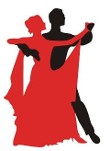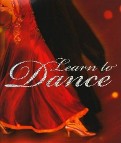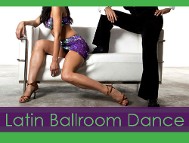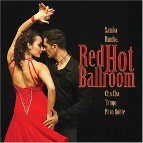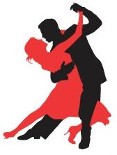Ballroom Dance Basics
About Ballroom Dancing
Ballroom dancing is often perceived as consisting of "traditional" dances such as waltz and foxtrot only.
Think again!
Modern ballroom dancing consists of many dances (see Common Dances) from all parts of the world and with appeal to all ages. You can choose stylish and elegant dances like the waltz, or more energetic swing and rhythm dances such as the Hustle, Paso Doble, Merengue and Salsa.
Get ready for an exciting adventure and see how ballroom dancing will improve your life and well-being.
Benefits of Ballroom Dancing
Most dancers are pleasantly surprised at the many additional ways in which their lives are enriched by joining the dance community:
Socialization - Most new students look to take their new skills to a specific venue such as a cruise, wedding or party. There are additional opportunities for socialization such as studio parties, dance competitions and clubs. Ladies and gentlemen alike will be pleased to know that dancers LIKE to dance. For men, good manners and gentlemanly behavior are rewarded by a "Yes, thank you" response. For ladies, ballroom dance provides the ability to enjoy dance and music in a safe and fun environment.
Fitness - Dancing rarely feels like exercise. However, participation in practice sessions, drills, lessons and social events provides an incredible amount of aerobic exercise and physical conditioning. Many dancers experience weight loss and muscle toning benefits as a direct by-product of participating in dance.
Agility - Dance steps and movements require using muscles and postures which are new to most people. The end result is that your body will become more flexible and nimble. Also increased grace and posture are by-products of dance technique and movement.
Mental Acuity - Dancing demands a high level of mental energy. Planning pattern movements, lines of direction and appropriate responses to floor conditions and partner directions hone a dancer's cognitive skills. Studies have confirmed side benefits such as staving off Alzheimer's.
Confidence and Self Esteem - the combination of increased mental and physical capabilities is an extraordinary boost to self confidence. Dancing skills can be readily transferred to other sports and leisure activities.
Look Better - proper dance posture and carriage add to improved physical conditioning and result in a dynamic, new you. Straighter spines, balanced footwork and arm-framing all result in the person your parents expected when saying "Stand up straight". Better posture results in a more attractive figure and a healthier skeleton.
Have Fun - last, but not least, dancing is FUN! Music, companionship and increased personal activity levels all combine to enrich your lifestyle in ways you could not have imagined.
After you learn the fundamentals of core dances, you will be able to expand your interests and skills in many ways in both private and public settings. We encourage you to further your learning by seeking professional instruction at your local "Dancesport" studio.
Dancing will make your life better.
Common Dances
American Smooth
Waltz
Tango
Foxtrot
Viennese Waltz
American Rhythm
Cha Cha
Rumba
East Coast Swing
Mambo
Bolero
Night Club
Salsa
Samba
Merengue
West Coast Swing
Hustle
Paso Doble
Nite-club Two-Step
International Standard
Waltz
Slow Foxtrot
Tango
Viennese Waltz
Quickstep
International Latin
Cha Cha
Rumba
Samba
Paso Doble
Jive
Finding a Dance Studio
Most cities will have franchised, brand-name and locally owned and operated studios.
Your selection of a studio should focus on the talents and abilities of the dance instructors and not just name recognition.
Please consider the following when making your selection:
Does the studio require you to sign a contract or pay as you go?
What is the cost of private and group lessons and how long are the lessons?
Do they offer periodic (ideally weekly) social dance (i.e. practice) parties? Cost?
What does the studio require to allow you to use their facility for practicing?
What is the studio's position on allowing you to participate in national competitions?
What are the dress requirements?
What is the mission of the studio owners? Meet them!
Who will be assigned to be your private instructor? What are their credentials?
Can you change instructors? How?
What are the lesson cancellation policies?
Social vs Competitive
We will teach you the foundation principles to become a social dancer.
Lessons from accredited studios will refine both your social and competitive dancing skills.
So what's the difference?
As far as your learning objectives, there is no difference. Lessons are there for you to be a better dancer regardless of your objective.
Social dancing provides the opportunity to dance in settings like parties, weddings, cruises. Social dancers enjoy dancing with their significant other and also with new partners who they meet at events. Events can be found at dance studios, dance clubs as well as community organizations.
Competitive dancing can be done with your instructor ("Pro/Am") or with another student ("Amateur") at local, regional, national and international events. Competitions provide an exciting venue to show off your skills, wear elegant costumes and travel to new places. Competitions will generally mandate more lessons and practice time and therefore require significant investments of both time and money. Competitive dancers consequently will tend to have higher skill levels and be more confident performers.
We provide new dancers a launching point into ballroom dancing, and to provide experienced dancers with background information and refreshers on some fundamentals.
However dancing is a social activity. It requires partners and is also an activity where even the best dancers in the world continue to learn and grow. Dancing also lasts forever. Unlike other sports, dancing can be done at any age.
So like any avocation, dancing requires an understanding of one's goals and then may require some "equipment" - primarily clothes and shoes.
Setting Goals
Since dancing can become a lifelong activity, it's important to establish goals, then continue to review and establish new goals.
You may start dancing because of an upcoming wedding or cruise. Many men are asked to start dancing by their wives as a joint hobby. As you become more captivated by dance, you will need to make decisions like:
Am I a social or competitive dancer? Both?
How much do I want to spend?
Do I like to perform in public (e.g. in showcase events)?
Do I want to dance with "strangers" (touch is a constant in dance)? Spouse or significant other only?
Then you need to set your goals and establish a budget (an annual plan usually makes sense). Work with your professional instructor honestly and openly to then define learning objectives and the best way to use your money.
Money can spent on many items such as:
lessons (private or group)
shoes
clothing
travel and lodging (for you and for your dance partners)
competition fees
Apparel
Dancing can be learned quite effectively without spending any money on apparel.
Nonetheless, here are some recommendations to follow as your budget permits:
Dance Shoes - proper dance shoes make it much easier to step, turn and spin on a wooden floor. Rubber soles are sticky and nasty, leather soles are passable. Dance shoes have suede soles to allow you to adjust the level of friction with the dance floor by using a special shoe brush. Ladies' shoes have strengthened heels and will be safer than normal high heels. One pair of "smooth" or "practice" shoes should be your first purchase, then if possible, you should add a pair of "latin" or "rhythm" shoes. Shoes are also available for International styles.
Smooth versus Latin shoes - for ladies smooth shoes have closed toes and latin shoes are open-toed. For men, the latin shoe will have a soft sole and bend almost like a glove to allow for greater flexibility when applying "Latin motion".
Practice Clothing - street clothes are fine for practice and business casual clothing is acceptable for most parties and social dancing. Getting practice clothes which stretch with your motions is handy, and popular yoga/exercise clothing works well.
Competitive Clothing - one of the fun aspects of competitive dancing is the ability to dress up formally in jackets, vests and gowns. Proper dance clothing is a must for pro/am competitions as everyone at the competition will be dressed to impress. Specialized clothing is designed to avoid bunching and to accentuate your styling.
Your Body
Your body is your primary dance instrument.
As you progress and build skills, your body will engage first with your feet,then upwards throughout the rest of your body. Eventually you will learn that dancing requires coordinated and synchronized management of many body parts such as:
Feet (ideally one left foot and one right foot as employing two of the same kind can be problematic)
Sections of feet (Toe, Ball, Heel, Inside Toe, etc.) - watch our videos and you will see how each foot consists of many parts.
Knees which are an engine to engineer leg extensions and sometimes changes in height.
Hips used to create sideways sway motions (e.g. ladies in smooth side movements and both in East Coast Swing steps after the "a"). CAUTION - the hips are NOT used to create Latin motion which emanates from weight shifts in the feet which cause hip rotations.
the "Center", consisting of a lower, middle and high center
Rib Cage, consisting of 2 sides, a front, a back and 4 diagonal points - used to create sway as well as rise
the "Frame", consisting of your arms, shoulders, collar bones in a united structure. Remember, raise your arms while your shoulders are in a relaxed downward sloping posture.
Arms - used for styling motions when they come free during patterns which are not in closed position.
the Head - required to take specified position such as looking to the left during smooth dances
the Eyes - constantly surveying the room, other dancers and picking up visual cues from one's partner, while continuing to look "static" and aloof. NEVER, NEVER watch your feet or your partner's feet.
the Hair - not exactly a muscle, but a body part which sometimes seems to take more time to manage than any other.
As you body will determine your dance proficiency, physical conditioning will derive naturally from your increased dance activities.
Nonetheless stretching, yoga and other aerobic exercises are recommended.
One thing we know for a fact. Your body WILL look and feel better as you dance more. Weight loss is not uncommon and posture improvements and skeletal integrity are almost unavoidable.
Practice Makes Perfect
As with any sport, practice is vital to improving your dance skills. Each step, each pattern and each dance defines a unit to be practiced. Your body will learn new ways to move.
Remember, practice is both a physical and a mental activity which has the end goal of developing muscle memory as well as intuitive memory.
Exercises
1. Stretching - use your full repertoire of stretching and aerobics drills from any other discipline to improve your stamina, flexibility and strength
2. . Warm Ups - step down the speed of a dance and practice steps slowly (e.g. practice Rumba using Bolero music)
3. Feet - with your weight on one foot, rotate contact around the circumference of your other foot so you learn that every edge and surface of a foot is a contact and pressure point.
4. Toe Rise - rise up on both toes and walk forward and sideways. Stop suddenly and stay up on both toes.
5. Cores & Spine - sit on the edge of a chair and push your rib cage diagonally to each corner without using your hips or shoulders
6. Shoulders - hold your arms up horizontally with elbows pointed to the sides and walk around without breaking the frame of our arms.
Don't shrug your shoulders upwards, keep them relaxed and sloping downwards.
7. Neck - rotate your head in a circular motion while lowering to the front and looking upwards when at the back. CAREFUL here if you have neck problems.
8. Latin Motion - practice the weight shift exercises shown in our glossary for 15 minutes each day.
9. Rumba Walks - repeat the forward or backwards steps shown in the Rumba Basic pattern, three steps forward, 3 steps back. Continue for 15 minutes while honoring the weight shift you learned above.
10. Dance each step, each pattern in each dance repeatedly until your feet work without conscious direction from your mind.
Technique & Styling
Technique and styling present life-long opportunities for learning and improvement. These are concepts to refine as your love of ballroom dance grows and not something you rush, especially without formal instruction in group or private lessons.
Technique generally refers to how you use your body parts in a synchronized manner to execute dance motions. Styling refers to how you accentuate your shaping and free movements to add grace, rise, fall and sway to your dance.
1. Feet (Smooth) - note how the feet are offset with the Responder shifted to the Leader's right side.
2. Feet (Rhythm) - note how the heels are in contact while the toes are turned out in all steps.
3. Bodies - the bodies face each other in closed position,
3. Hands - in closed position the Responder's right hand is in the Leader's left. The Responder's left hand is placed lightly on the Leader's right arm while the Leader's right hand rests on the Responder's back.
5. Heads (Smooth) - the Leader's head point to the left as if looking over his left breast pocket. The Responder looks to her left as well. The heads do not face one another. resist looking at each other's eyes.
6. Heads (Rhythm) - the heads face one another in closed position.
7. Eyes - NEVER look at your feet while dancing. NEVER look at your partner's feet either. Keep your eyes trained on an imaginary wall sconce behind your partner. Looking down will result in loss of balance and will disrupt your timing.
8. Hips and Torso - keep these as still and upright as possible. No wiggling! Try and start your forward movements with your torso and not your feet just as you normally do when you walk. Check it out - your forward walking step starts in your "center" not your foot.
9. Arms - the Responder is the seller of the dance and she gets to make fancy, stylish arm motions. The Leader uses his arms to "protect" the dance space, as if warding off intruders from his partner.
10. Shoulders - when the arms some up into frame, the shoulders should remain RELAXED. Avoid shrugging your shoulders when raising your arms.
Other key concepts described in the glossary:
Connection - there should always be a connected feeling between dance partners so a Leader ca send and a Responder can receive instructions through contact between the bodies.
Weight Transfer - the weight is constantly shifting between feet AND between parts of your feet, In Rhythm for example, weight actually rolls from the Heel through the Ball to the Toe. In Smooth danced you will often rise to your toes, then lower your weight gently to your heels.
Rise and Sway - these visual effects are achieved by a combination of toe, knee and torso movements.
Cuban (or Latin) Motion - this is fundamental for your rhythm dances such as Rumba and Cha Cha. Turn the feet out, connect you heels and then achieve hip rotation around your spine by using weight transfer - NOT hip wiggling.
Positions & Responsibilities of Partnership
Both partners have their own responsibilities and each must execute these in harmony to achieve a positive dance outcome.
The Leader initiates every action on the floor and the Responder must FEEL these instructions, mostly through contact and sometimes through sight.
The leader LEADS. Rightly or wrongly, the Responder must follow the leader's instructions whether he is on time or not. The Responder can send a signal to the Leader to reset usually through hand pressure on his shoulder or to his left hand. A good leader should respect his partner's feedback and adjust timing or better yet for beginners, pause and restart a dance movement or pattern.
Good dancing requires complete teamwork, more than any other sport or activity. Golfers may sit in the same cart and talk, but dancers must continually interact with their partners. Remember the dance team was Astaire and Rogers, not one or the other. People watch and enjoy the totality of a couple and not one partner only.
Leader
The Leader's primary responsibilities are:
1. Protect the responder - the leader has to protect the responder by creating a bubble or cocoon around her and prevent intruders from entering their dance space. Good manners also require that the Leader not violate another couple's dance space either. A Responder can help when the Leader is moving backwards by alerting him through hand pressure in case of potential collisions.
2. Find the beat and time the dance movements and - it's the Leader's job to determine what beat of music will initiate his first step. Help a Leader learn his beat interpretation. If your lady is better at this, then have her help you through hand pressure or other pre-arranged cues. The Leader is the only person who moves in time to the music because by definition the Responder MUST lag the leader by a fraction of time.
3. Communicate movements to the Responder - movements are communicated to the Responder by body movements and not by moving the arms and hands. When the Leader MOVES forward, the Responder will sense this movement through their Connection and take a corresponding backward step.
4. Pick the patterns and steps - the Leader has to decide what patterns and steps will be executed, ideally ahead of time, and more ideally through practices muscle memory so there is no decision lag time. The Responder should NEVER anticipate the step and it's often best to not go anywhere than trying to guess what you were supposed to do. The Leader must constantly learn based on feedback from responders and improve his communication abilities.
5. Provide power and impetus WITHOUT manipulation - manipulation typically happens by forcing movements by using one's hands or arms. Power and impetus are best provided through body movements and turns.
So by definition, remember that dance instructions in lessons are usually for the Leader and not the Responder. The Responder has to take communication from the Leader.
Together, the couple uses Compression (moving into each other), Tension (opposite of compression but still requiring physical contact to effect communication) and Leverage (typically the Leader using the Responder's momentum) to define the dance interaction further.
Both Leader and Responder must interact as a team to fully execute the character and expression of a dance, with the following joint objectives:
1. use the appropriate motions such as Latin Motion for rhythm dances or Rise and Fall for smooth dances.'
2. work like a single, four-legged entity with coordinated actions and reactions off one another.
3. have fun while executing with precision and grace.
Responder
The Responder's primary responsibilities are:
1. Respond to one step only - the Leader communicates a step, not a pattern, so the Responder must understand and execute only the step being led. Never anticipate the lead.
2. Provide power for backward movements - if the Leader starts a backward step, the Responder needs to provide the impetus for this step.
3. Re-establish position and connection - the Responder needs to be aware of the Leader's ending position and hand/arm positions. A step may end with a request to provide the free hand back to the Leader versus leaving it free for styling. The Responder also needs to move back into a closed position after a released step so the Leader can execute the next step without "reaching".
Styling and presentation - People watch when couples dance. Part of why we do so is to entertain and make our dance's story believable. She essentially "sells" the character of each dance the couple performs.
So by definition, remember that dance instructions in lessons are usually for the Leader and not the Responder. The Responder has to take communication from the Leader.
Together, the couple uses Compression (moving into each other), Tension (opposite of compression but still requiring physical contact to effect communication) and Leverage (typically the Leader using the Responder's momentum) to define the dance interaction further.
Both Leader and Responder must interact as a team to fully execute the character and expression of a dance, with the following joint objectives:
1. use the appropriate motions such as Latin Motion for rhythm dances or Rise and Fall for smooth dances.'
2. work like a single, four-legged entity with coordinated actions and reactions off one another.
3. have fun while executing with precision and grace.
Floorcraft & Etiquette
Floorcraft and etiquette on the floor go together to result in a harmonious and enjoyable experience for everyone on the dance floor.
Different couples may choose to perform different dances to the same music. The dance floor can be viewed as an oval track similar to a horse-racing or NASCAR track. As in races, the couples who choose a traveling dance like Waltz will move in a counter-clockwise direction around the periphery of the dance floor. Dancers who choose a non-traveling dance should stay off the outside track and occupy the "in-field" or middle of the dance floor. When a Rumba song is played and everybody chooses the same dance, then there is no outside traveling track and all Leaders choose places which allow them room to maneuver cleanly as each step and pattern is selected..
The outside track is referred to as the Line of Dance (LOD). Traveling dances such as the Smooth dances are all designed to follow LOD conventions.
Regardless, the Leader (who is the person who decides on Direction and Pattern) is obligated to make these decisions with the Safety of the Responder and other dancers in mind. The Leader should not choose a pattern which requires movement if other dancers are occupying the destination. Likewise in traveling dances, the Leader is responsible for choosing steps which avoid or prevent collisions with other dancers ahead of his partner. The Responder also has to support this role when the Leader chooses to move Backwards to the LOD and alert the leader of collisions through hand pressure or resistance to his backward movement.
Good etiquette requires that entry to the dance floor should be managed by the Leader to minimize disruption to other dancers.
